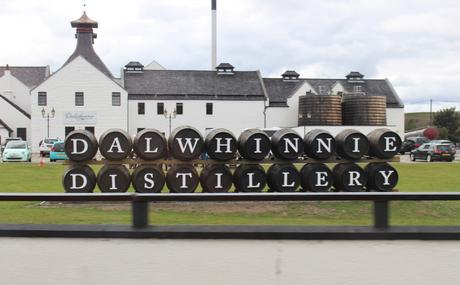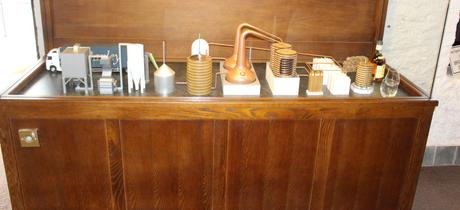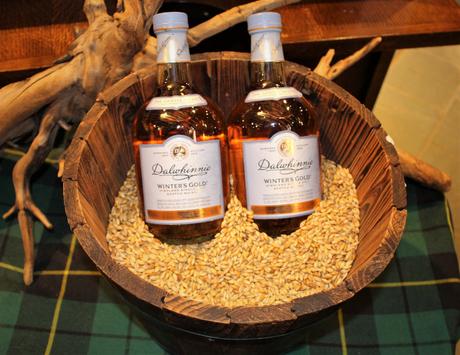As we are hunkered down with the threat of coronavirus, I am reminded of a time when we could travel freely about the globe...
 On my trip to Scotland with Benita and The Urchins (aka My Wife and Kids, not some early 60s British pop band) way back in July of 2018, we booked a Hairy Coo trip to the Highlands. Whilst traipsing around Inverness and Skye, we passed signs for Deanston, Ben Nevis & Talisker, and just as I thought my hopes of visiting a distillery were dashed, the bus stopped at the Dalwhinnie Distillery (okay, fine! I knew all along that the bus was stopping at Dalwhinnie). Upon arrival, our bus driver provided the rundown on the tickets; the Urchins would be £6 each, while Benita and I had a choice of either 2 whisky samples for £8 or 6 whisky samples for £20. After a very brief moment of hesitation, we decided to go with the 6 samples for £20 option.
On my trip to Scotland with Benita and The Urchins (aka My Wife and Kids, not some early 60s British pop band) way back in July of 2018, we booked a Hairy Coo trip to the Highlands. Whilst traipsing around Inverness and Skye, we passed signs for Deanston, Ben Nevis & Talisker, and just as I thought my hopes of visiting a distillery were dashed, the bus stopped at the Dalwhinnie Distillery (okay, fine! I knew all along that the bus was stopping at Dalwhinnie). Upon arrival, our bus driver provided the rundown on the tickets; the Urchins would be £6 each, while Benita and I had a choice of either 2 whisky samples for £8 or 6 whisky samples for £20. After a very brief moment of hesitation, we decided to go with the 6 samples for £20 option.
At the start of our tour, our guide, Davy, provided a bit of history on both the Village of Dalwhinnie and the Distillery. Dalwhinnie is located at the head of Glen Truim and the north-east end of Loch Ericht, on the western edge of the Cairngorms National Park. The Village of Dalwhinnie is the coldest village (by average daily temperature) in the United Kingdom and the Distillery operates at the highest elevation in all of Scotland. Both the elevation and cold temperatures play a significant role in shaping the flavor of the whiskies. So much so, that the master distiller halted production for two weeks as unseasonably high temperatures prior to our arrival led to water temperatures that were too warm, resulting in a yield that was very un-Dalwhinnie-like.
In terms of ownership and mere existence, Dahlwhinnie Distillery has quite the tumultuous history...
- Established by John Grant in 1897
- Moved into liquidation prior to opening in 1898
- Held by a variety of companies until it was purchased by Distillers Company in 1926
- Burned down in 1934
- Rebuilt in 1937
- Merged into United Distillers in 1987
- Incorporated into Diageo in 1997
It was United Distillers who took six different expressions from six different Scottish distilleries to create the Classic Malts (Dalwhinnie 15, Glenkinchie 12, Cragganmore 12, Talisker 10, Oban 14, and Lagavulin 16). Diageo has continued to package these expressions together, and it is not uncommon to see the six bottles side-by-side at your favorite whisky bar.
Davy limited photos during the tour (no electronics near the oh, so flammable liquid gold!), so I am unable to properly capture the sheer size of the Distillery's inner workings which once employed 40 people. Thanks to automation, the distillery employs just 6 people (five men and their female master distiller). To put that into perspective, there are now 22 people employed in the visitors' center.

We were then led into the lobby to learn about the malting process with good visual (and nasal) aids to assist with the lesson. After a brief explanation about the use of peat in whisky making, we were taken up a flight of stairs and led into the mashing room where they have a neat little window that allows visitors to see what goes on in the tun as the clear, cold water and malted barley are combined and heated. Leaning into the tun, you can feel the heat (about 80 degrees) emanating from within. During this stop, Davy gave us a brief lesson on Scottish ingenuity. After the liquid wort is piped into the fermentation tanks next door, the leftover mash is taken into another processing room where it's dried and compressed into hard pellets that are then sold to feed producers who in turn sell their product to livestock farms.
Once out of the mashing room, we saw the massive fermentation tanks which are made of very dense Siberian Larch and built to last around 60 years. This is where the distiller's yeast is added to the wort. There was a sweet aroma throughout the room and you pick up notes of honey and citrus as the fermentation brings the ABV of the wash up to about 9%. During this process, carbon dioxide (CO2) is released within the well-ventilated room. Davy mentioned that there are plans in development to hopefully capture this gas which would then be sold off as an additional source of revenue.
As an aside, I'm sure you are well aware that the barrels used to age Scotch whisky are imported from all over the world with the majority of them coming from Kentucky and Spain. These barrels are broken down prior to shipping and then reassembled by a cooper upon arrival in Scotland. The reason for this breaking down and rebuilding process is as one Scotch Whisky Brand Ambassador once told me, "The Scots don't pay for air". Given that reasoning, if they can get this recapturing of CO2 plan to work, while Scottish distillers may not PAY for air, they will certainly SELL you air.
OK, back to the tour...
The wash is then piped into the still room where the massive Scottish-made copper stills stand (the stills were replaced in April of 2018 and are expected to last 15-20 years). There are two stills; one slightly taller than the other. The first distillation takes place as the wash is heated in the shorter of the two stills, and the resulting low wines (up to an ABV of about 22%) are then run through a second distillation in the taller still (up to 64% ABV). The resulting alcohol is then run through the spirit safe where the impurities are taken out (foreshots and feints or heads and tails). The feints are then sold off as industrial and medicinal grade alcohol. Thanks to modernization, the distillation process allows for three separate and distinct products to be captured, packaged and sold before a single drop of whisky is bottled. These alternative products help to defray some of the distillery's production costs.
The next stop on the tour was one of the two racked warehouses. The area is not very tall as the barrels are stored no more than 3 racks high, but it is fairly wide. The combined capacity of the two warehouses is around 5,000 barrels.
Three takeaways from the barrelhouse tour:
- Once again, we were not permitted to use flash photography as the flash could ignite the fumes and that would be very bad.
- The whisky held in the barrelhouse is not all produced by Dalwhinnie as they will lend space to other distilleries at no charge. I saw barrels stamped with the names of at least 5 other distillers from all over Scotland.
- During my meanderings about the barrelhouse, I noticed a barrel that was stamped with the year 1960. Because the whisky had no discernible distillery name on it, it won't be bottled anytime soon because prior to bottling, the whisky is owned by the government. Once bottled, the distillery pays the taxes which amount to about 75% of the cost of whisky. Sadly, until this orphan barrel's provenance can be determined, it will sit at Dalwhinnie and continue to lose its angels share. Thanks to a gentle barrel rocking by Davy, we guesstimated that it seemed to be about half full. I can only imagine how good that 60 year old whisky must have tasted!
While in the warehouse, we received two of our six samples. This was a fantastic presentation as we stood amongst the barrels and sampled the Dalwhinnie 15 and the Winters Gold, both of which were bottled at 43%. I've had the 15 on numerous occasions. The Winters Gold was a spicier version of the 15. Although there was nothing mind-blowing about these expressions, both whiskies were solid representations of what Dahlwhinnie produces, i.e. solid, easy-drinking drams.

Our last stop, like any good tour or Disney ride, was the gift shop. With the bulk of Dalwhinnie production set aside for other Diageo blends such as Buchanan and Black & White, it's rare to find many Dalwhinnie expressions beyond the standard-issue 15 year old expression in NJ, so whilst wandering around the gift shop, I felt like a kid in a candy store!
Unfortunately, with restrictions on how many bottles I could bring back to the US, I had to take some time and make an informed purchase. While I was meandering around the store, Dalwhinnie set up a table for a special guest, the recently retired Liz Stewart, Scotland's first female operator in Malt Distilling who was posing for pictures and signing bottles of Lizzie's Dram, a limited edition expression that was released in her honor. It was such a treat to meet a whisky icon!
While Dalwhinnie might not have been my first choice of Scottish distillery to visit (they just don't send enough of their own expressions to the US to have made me a fan), it was a really well-done tour. Between the history, the whisky, the gift shop, and the opportunity to meet Liz Stewart, this tour checked all the boxes and I would highly recommend a visit if you happen to be traveling to the Highlands. Slainte!
Categories: Booze Review, Dalwhinnie
Tagged as: Dalwhinnie, Distillery Tour, Family Vacation, Review, Reviews, Scotland, Summer Vacation, Travel, Whiskey, Whisky

